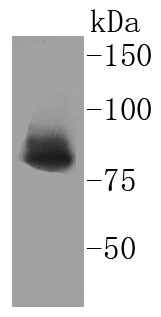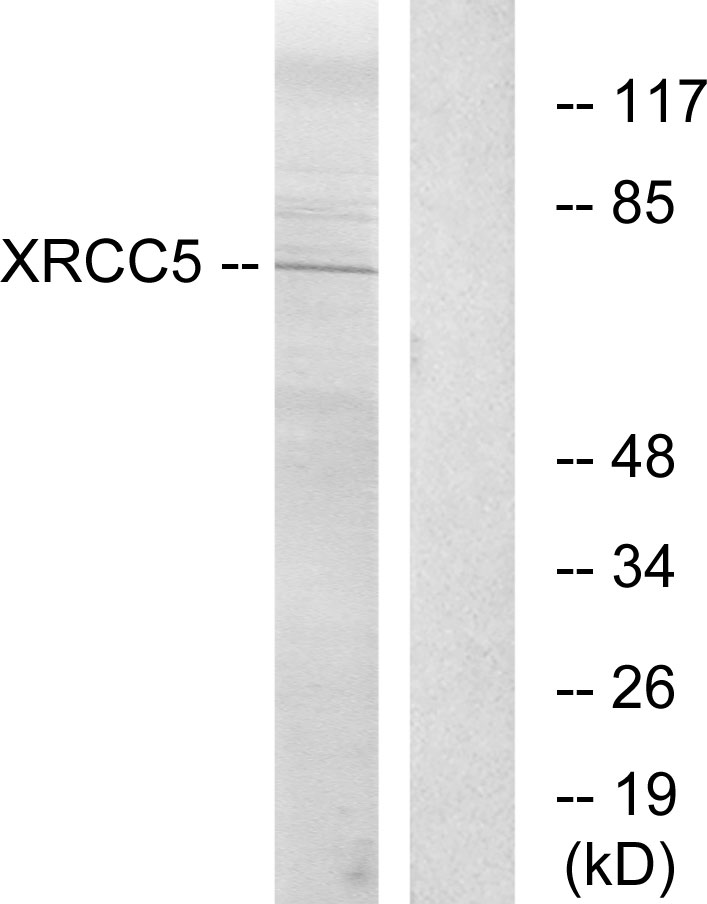Ku80 antibody [N3C2], Internal
GTX109935
ApplicationsImmunoFluorescence, ImmunoPrecipitation, Western Blot, ImmunoCytoChemistry, ImmunoHistoChemistry, ImmunoHistoChemistry Paraffin, Other Application
Product group Antibodies
ReactivityHuman, Mouse, Rat
TargetXRCC5
Overview
- SupplierGeneTex
- Product NameKu80 antibody [N3C2], Internal
- Delivery Days Customer9
- Application Supplier NoteWB: 1:500-1:3000. ICC/IF: 1:100-1:1000. IHC-P: 1:100-1:1000. IP: 1:100-1:500. *Optimal dilutions/concentrations should be determined by the researcher.Not tested in other applications.
- ApplicationsImmunoFluorescence, ImmunoPrecipitation, Western Blot, ImmunoCytoChemistry, ImmunoHistoChemistry, ImmunoHistoChemistry Paraffin, Other Application
- CertificationResearch Use Only
- ClonalityPolyclonal
- Concentration0.41 mg/ml
- ConjugateUnconjugated
- Gene ID7520
- Target nameXRCC5
- Target descriptionX-ray repair cross complementing 5
- Target synonymsKARP-1, KARP1, KU80, KUB2, Ku86, NFIV, X-ray repair cross-complementing protein 5, 86 kDa subunit of Ku antigen, ATP-dependent DNA helicase 2 subunit 2, ATP-dependent DNA helicase II 80 kDa subunit, CTC box-binding factor 85 kDa subunit, CTC85, CTCBF, DNA repair protein XRCC5, Ku autoantigen, 80kDa, Ku86 autoantigen related protein 1, TLAA, X-ray repair complementing defective repair in Chinese hamster cells 5 (double-strand-break rejoining), lupus Ku autoantigen protein p86, nuclear factor IV, thyroid-lupus autoantigen
- HostRabbit
- IsotypeIgG
- Protein IDP13010
- Protein NameX-ray repair cross-complementing protein 5
- Scientific DescriptionThe protein encoded by this gene is the 80-kilodalton subunit of the Ku heterodimer protein which is also known as ATP-dependant DNA helicase II or DNA repair protein XRCC5. Ku is the DNA-binding component of the DNA-dependent protein kinase, and it functions together with the DNA ligase IV-XRCC4 complex in the repair of DNA double-strand break by non-homologous end joining and the completion of V(D)J recombination events. This gene functionally complements Chinese hamster xrs-6, a mutant defective in DNA double-strand break repair and in ability to undergo V(D)J recombination. A rare microsatellite polymorphism in this gene is associated with cancer in patients of varying radiosensitivity. [provided by RefSeq]
- ReactivityHuman, Mouse, Rat
- Storage Instruction-20°C or -80°C,2°C to 8°C
- UNSPSC12352203
References
- Chen RY, Lin CJ, Liang ST, et al. UVB Irradiation Induced Cell Damage and Early Onset of Junbb Expression in Zebrafish. Animals (Basel). 2020,10(6). doi: 10.3390/ani10061096Read this paper
- Bottoni G, Katarkar A, Tassone B, et al. CSL controls telomere maintenance and genome stability in human dermal fibroblasts. Nat Commun. 2019,10(1):3884. doi: 10.1038/s41467-019-11785-7Read this paper
- Chen MK, Du Y, Sun L, et al. H(2)O(2) induces nuclear transport of the receptor tyrosine kinase c-MET in breast cancer cells via a membrane-bound retrograde trafficking mechanism. J Biol Chem. 2019,294(21):8516-8528. doi: 10.1074/jbc.RA118.005953Read this paper
- Chang CF, Chu PC, Wu PY, et al. PHRF1 promotes genome integrity by modulating non-homologous end-joining. Cell Death Dis. 2015,6(4):e1716. doi: 10.1038/cddis.2015.81Read this paper
- You BJ, Wu YC, Lee CL, et al. Non-homologous end joining pathway is the major route of protection against 4β-hydroxywithanolide E-induced DNA damage in MCF-7 cells. Food Chem Toxicol. 2014,65:205-12. doi: 10.1016/j.fct.2013.12.026Read this paper
- Chiang JH, Yang JS, Lu CC, et al. Effect of DNA damage response by quinazolinone analogue HMJ-38 on human umbilical vein endothelial cells: evidence for γH2A.X and DNA-PK-dependent pathway. Hum Exp Toxicol. 2014,33(6):590-601. doi: 10.1177/0960327113504791Read this paper
- Masuda Y, Noguchi K, Segawa H, et al. Novel regulatory role for Kaposi's sarcoma-associated herpesvirus-encoded vFLIP in chemosensitization to bleomycin. Biochem Biophys Res Commun. 2011,415(2):305-12. doi: 10.1016/j.bbrc.2011.10.050Read this paper






![ICC/IF analysis of HeLa cells using GTX66843 Ku80 antibody [8H1]. Dilution : 1:400](https://www.genetex.com/upload/website/prouct_img/normal/GTX66843/GTX66843_20190305_ICCIF_w_23061221_716.webp)